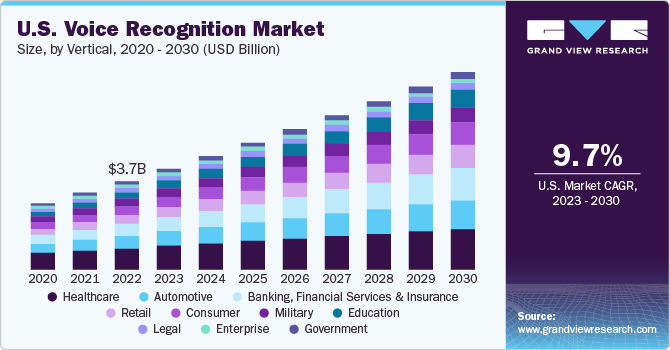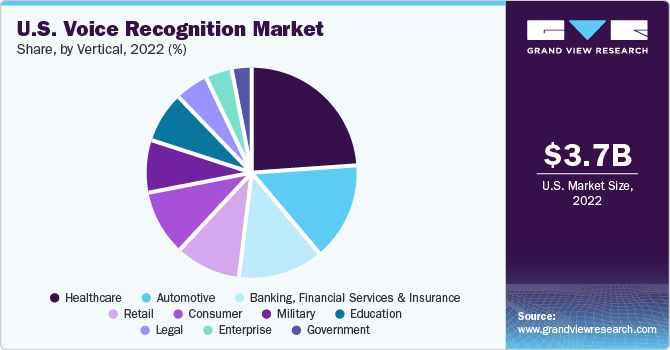- Home
- »
- Next Generation Technologies
- »
-
U.S. Voice Recognition Market Size & Share Report, 2030GVR Report cover
![U.S. Voice Recognition Market Size, Share & Trends Report]()
U.S. Voice Recognition Market Size, Share & Trends Analysis Report By Vertical (Automotive, Enterprise, BFSI, Government, Retail, Healthcare, Military, Education), And Segment Forecasts, 2023 - 2030
- Report ID: GVR-3-68038-738-4
- Number of Report Pages: 144
- Format: PDF, Horizon Databook
- Historical Range: 2017 - 2021
- Forecast Period: 2022 - 2030
- Industry: Technology
U.S. Voice Recognition Market Size & Trends
The U.S. voice recognition market size was valued at USD 3.71 billion in 2022 and is anticipated to grow at a compound annual growth rate (CAGR) of 9.7% from 2023 to 2030.The market is anticipated to be driven by advancements in technologies, the escalating use of voice recognition in advanced computer-controlled electronic devices, and the growing use of technology in biometric systems. Voice-activated biometric systems used for security purposes help in providing access to authenticated users for performing a transaction.

The rising demand for voice-enabled biometrics in the banking and enterprise sectors is expected to fuel growth in the U.S. market for voice recognition. Furthermore, the increasing usage of voice-driven in-car automotive infotainment systems in the automotive sector and the increased usage of speech technology for navigation purposes in mobile map applications are anticipated to fuel industry expansion.
As the Internet of Things (IoT) technology finds growing use across a range of industrial, commercial, and residential applications in the U.S., a rising number of consumers are interacting with connected devices. This has paved the way for the integration of voice recognition technology with these connected devices, thus driving the demand for voice-enabled devices. This factor is expected to drive the country’s market for voice recognition over the forecast period. The technology is being increasingly adopted in consumer electronics devices such as smartphones, laptops, and other IoT-enabled devices.
Industry players in the U.S. are focusing on offering services such as voice-enabled intelligent personal assistants through programs and software. Home automation is another major area that is expected to drive the demand for this technology. The use of verbal commands in smart homes to control entities such as lights, room temperature, and doors is strongly contributing to the country’s market growth. For instance, in August 2022, Amazon.com, Inc. launched its wall-mounted echo, sound bot, and home robot, as part of the company’s yearly model upgrade of its Amazon Echo smart speaker.
The increased uptake of voice recognition technology in the banking sector is driven by the introduction of voice-enabled biometric systems for purposes such as accessing core credentials and customer logins. Furthermore, customers are preferring biometrics over conventional methods of authentication, which is projected to have a positive impact on market growth over the forecast period.
Vertical Insights
Based on vertical, the U.S. voice recognition market has been segmented into automotive, enterprise, consumer, BFSI, government, retail, healthcare, military, legal, education, and others. The healthcare segment held the largest revenue share of 22.4% in 2022, owing to the rising need for precise & efficient documentation and the growing demand for telemedicine services.
For instance, in 2022, Amazon unveiled a cutting-edge solution for hospitals that incorporates speech intelligence on a larger scale into healthcare facilities. The solution, known as Alexa Smart Properties, promises to make it much more convenient for hospitals and senior care centers to install and run Alexa-enabled devices throughout their premises, leading to improved healthcare services.

The banking, financial services, & insurance segment is expected to expand at the fastest CAGR of 13.2% over the forecast period. This growth is due to the rising need for enhanced and reliable security measures, improved customer experience, efficiency, cost-effectiveness, and integration of voice recognition with other technologies such as AI and Natural language processing (NLP). Additionally, the segment is anticipated to grow as voice-assisted digital payment technologies continue to advance.
For instance, ToneTag has been working with public sector organizations in India to offer UPI 123Pay options to its customers. Through this service, feature phone users can dial the relevant IVR number and conduct financial transactions using their voice as input. Customers can perform financial activities such as paying utility bills, checking account balances, recharging, and more, using this service.
The automotive segment is also expected to account for a significant share of the market in the U.S. over the forecast period. The increased use of voice recognition technology in a variety of automotive applications such as remote control, car navigation, and verbal commands for in-car infotainment systems is poised to drive strong segment growth. The United Services Automobile Association (USAA) uses this technology for authentication for users to access their USAA accounts on their mobile devices. Its biometric system offers three quick login options - fingerprint, face, or voice recognition.
Applications of voice recognition technology are also increasing in the field of home security and health monitoring. Advanced security and smart systems can monitor the surrounding conditions and interact with residents to process commands such as adjusting thermostats, turning on or turning off lights, identifying residents or employees, and reporting intruders, based on definite biological signs. These applications are expected to lead to new avenues of growth for the U.S. market over the forecast period.
Key Companies & Market Share Insights
The leading players in the market are undertaking strategies such as product developments, mergers and acquisitions, strategic partnerships, and business expansions, to maintain a strong hold of the market. For instance, in September 2022, Paychex Inc., a leading provider of comprehensive human resource management software solutions, introduced ‘Paychex Voice Assist’ for Paychex Flex, the company's SaaS-based HR software product. The new conversational AI feature streamlines and automates the payroll procedure by utilizing the audio of an authenticated user's voice, enabling payroll managers to control payroll hands-free, using any Google Assistant-compatible device.
Key U.S. Voice Recognition Companies:
- Advanced Voice Recognition Systems, Inc.
- Nuance Communications Inc.
- Amazon.com, Inc.
- Keda Xunfei Co., Ltd.
- Apple Inc.
- Baidu, Inc.
- Google LLC
- International Business Machines Corporation
- M2SYS Technology
- LumenVox
- Microsoft
Recent Developments
-
In October 2022, the University of Illinois Urbana-Champaign (UIUC) announced a partnership with Apple Inc. and other tech giants on a new Speech Accessibility Project. This project seeks to advance voice recognition technology to cater to individuals with speech anomalies and disabilities
-
In September 2021, Gnani Innovations Private Limited, an India-based conversational AI technology and voice security company, announced the release of armour365, its voice-based biometrics software. The biometric system finds applications in a variety of industries including banking, military, and healthcare
U.S. Voice Recognition Market Report Scope
Report Attribute
Details
Revenue forecast in 2030
USD 8.02 billion
Growth Rate
CAGR of 9.7% from 2023 to 2030
Base year for estimation
2022
Historical data
2017 - 2021
Forecast period
2023 - 2030
Report updated
November 2023
Quantitative units
Revenue in USD million and CAGR from 2023 to 2030
Report coverage
Revenue forecast, company ranking, competitive landscape, growth factors, and trends
Segments covered
Vertical
Country scope
U.S.
Key companies profiled
Advanced Voice Recognition Systems, Inc.; Nuance Communications Inc.; Amazon.com, Inc.; Keda Xunfei Co., Ltd.; Apple Inc.; Baidu, Inc.; Google LLC; International Business Machines Corporation; M2SYS Technology; LumenVox; Microsoft
Customization scope
Free report customization (equivalent up to 8 analyst’s working days) with purchase. Addition or alteration to country, regional & segment scope
Pricing and purchase options
Avail customized purchase options to meet your exact research needs. Explore purchase options
U.S. Voice Recognition Market Report Segmentation
This report forecasts revenue growth at the country level and provides an analysis of the latest industry trends in each of the sub-segments from 2017 to 2030. For the purpose of this study, Grand View Research has segmented the U.S. voice recognition market report on the basis of vertical:
-
Vertical Outlook (Revenue, USD Million, 2017 - 2030)
-
Automotive
-
Enterprise
-
Consumer
-
Banking, Financial Services & Insurance
-
Government
-
Retail
-
Healthcare
-
Military
-
Legal
-
Education
-
Others
-
Frequently Asked Questions About This Report
b. The U.S. voice recognition market size was estimated at USD 3.71 billion in 2022 and is expected to reach USD 4,201.9 million in 2023.
b. The U.S. voice recognition market is expected to grow at a compound annual growth rate of 9.7% from 2023 to 2030 to reach USD 8.02 billion by 2030.
b. The healthcare segment dominated the U.S. voice recognition market with a share of 22.3% in 2022. This is attributable to growing applications of the technology in medical chatbots.
b. Some key players operating in the U.S. voice recognition market include Advanced Voice Recognition System, Inc.; Agnitio S.L.; Amazon.com; Inc.; Keda Xunfei Co., Ltd.; Apple Inc.; Baidu, Inc.; Google LLC; and International Business Machines Corporation.
b. Key factors that are driving the market growth include increasing demand for voice biometric systems for user authentication and growth of voice recognition in-car infotainment systems.
Share this report with your colleague or friend.
![gvr icn]()
NEED A CUSTOM REPORT?
We can customize every report - free of charge - including purchasing stand-alone sections or country-level reports, as well as offer affordable discounts for start-ups & universities. Contact us now
![Certified Icon]()
We are GDPR and CCPA compliant! Your transaction & personal information is safe and secure. For more details, please read our privacy policy.
We are committed towards customer satisfaction, and quality service.
"The quality of research they have done for us has been excellent."





